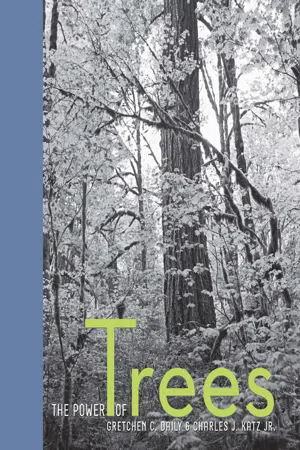
- 64 pages
- English
- ePUB (mobile friendly)
- Available on iOS & Android
The Power of Trees
About This Book
Intimate in size yet quietly breathtaking in scope, this graceful gift book will forever change how you think, and how you feel, about trees. In poetically sparse scientific observations, renowned conservation biologist Gretchen Daily narrates the evolution, impact, and natural wonder of trees. Alongside photographs by Chuck Katz, the text and images form a quiet and moving meditation on The Power of Trees. Twenty-six duotone black and white photographs illustrate the development of trees: how trunks were formed, what tree rings tell us about human societies, and how trees define the future of humanity. Pictures of trees threading through the landscape - dotting mountainsides, braiding along the sides of glassine rivers - bear witness to the lyrical force and clarity of Daily's observations.Recreating the authors’ hike together through the landscape of the Skagit River in Washington State, the balletic movement between Daily’s commentary and Katz’s vision reaches out to readers, inviting them to enjoy the landscape through a scientific understanding of trees. At once emotional and intellectual, The Power of Trees is the first collection of nature photographs that invites the reader to not only delight in the gorgeous play between light and shadow, but also the fascinating natural mechanisms that create such striking natural beauty.An ecologist by training, Gretchen Daily is an internationally acclaimed conservancy advocate and scholar. Her role as a National Trustee for The Nature Conservancy will feature prominently in the national marketing campaign to bridge the gap between scientific educators and the general nature reader.
Frequently asked questions
Information
Trees live on through sound . . .




. . . trees define our lives
Table of contents
- Cover
- Title Page
- Dedication
- Contents
- Trees seem so still . . .
- . . . the essence of life is renewal
- Some trees can talk to one another . . .
- . . . trees depend on intimate partnerships . . .
- . . . trees became trees several times over
- How far can trees push the limits?
- Heartwood is . . . as strong as steel
- . . . the tree keeps growing . . .
- Tree rings let us
- read into the past like the pages of a book . . .
- . . . trees’ life processes might possibly go on
- forever . . .
- Trees live on through sound . . .
- . . . trees define our lives
- Acknowledgments
- Copyright
- About the Author